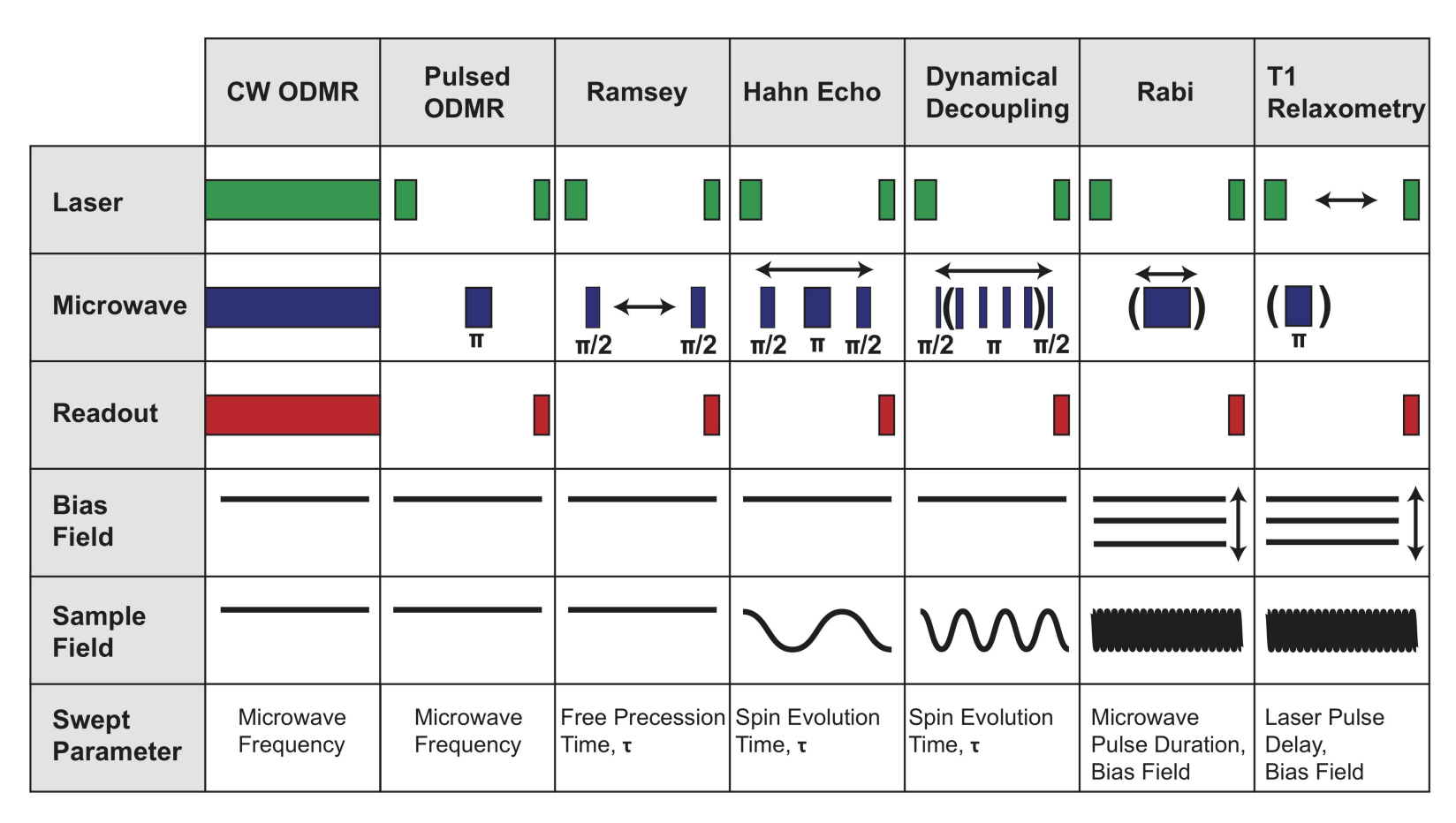GUI-version desktop application of Odmactor (ODMR Actor), building on PyQt5.
- Frequency-domain detection
Scan MW frequencies- Continuous-Wave ODMR
- polarize spin systems
- operate continuous MW and readout signals for the whole sequence period
- Pulse ODMR
- polarize spin systems
- apply a fixed-interval MW pulse
- readout final fluorescence signals
- Continuous-Wave ODMR
- Time-domain detection
Scan time intervals- Ramsey detection
- initialize spin to ground state
- initialize spin to equal-amplitude superposition state using calibrated MW
$\frac{\pi}{2}$ pulse - wait for a time interval
$\tau$ - operate a calibrated MW
$\frac{\pi}{2}$ pulse again - readout final spin state (population)
- Rabi oscillation
- initialize spin to ground state
- operate a short MW pulse (100~200 ns)
- readout final spin state (population)
- T1 relaxation
- initialize spin to excited state using calibrated MW
$\pi$ pulse - wait a time interval
$\tau$ - readout final spin state (population)
- initialize spin to excited state using calibrated MW
- Hahn echo Sequences are similar with those for Ramsey detecting, while there is an additional MW π pulse between the two π/2 pulses.
- High-order dynamical decoupling Sequences are similar with those for Ramsey detecting, while there are N additional MW π pulse between the two π/2 pulses.
- Ramsey detection
- Spin manipulation
Currently not implemented
The above specific scheduling methods could be abstracted into different detection sequences in experiments. They are all controlled in precision of "ns".
Thus the series of ODMR measurement experiments is simplified by a "pipeline". CW and Pulse ODMR could be used to characterize environmental physical quantities, while they also could be used to calibrate energy gap or fine structures. Ramsey detecting is usually used to characterize T2* (dephasing time) of spin systems. Some typical results of them are like the following figure.
For detailed operation guidance please reach to the software user manual.
Herein some illustrations are for a glance.
Most general hardware resources are supported by our Odmactor programs. Below are some essential instruments usde in a systematic ODMR platform and directly controlled by our programs currently used in our QIM group.
Arbitrary Sequence Generator (ASG)
This is the most important instrument to synchronize control measurement processes.
- Vendor: CIQTEK
- Type: ASG8005
- Feature: 8 control channels
Microwave instrument (MW)
Time Tagger (Tagger)
This is a T/D convertor as well as A/D convertor necessary for data acquisition.
- Vendor: Swabian
- Type: Time Tagger 20
- Feature: 8 detecting channels, 34 ps jitter, 8 M tags/s
Lock-in Amplifirer
Lock-in is a mature manner to detect weak signals, and this device manufactured by Standford Research is a usual lock-in amplifier.
- Vendor: Stanford Research
- Type: RS830
- Feature: 1 mHz ~ 102.4 kHz range, 0.01 degree resolution
Data Acquisition board
NI DAQ device is used when using lock-in detecting mode instead APD with Time Tagger mode.
- Vendor: National Instruments
The core scheduling algorithms of this software is based on another open-source SDK project. More details can be found on the corresponding GitHub Page.
Q: Where should I get to know more about Odmactor?
A: If you have more demand or cooperation willingness, please contact to the Quantum Information and Materials Group of the University of Arizona.
Q: Can I modify this set of programs for my own research?
A: Of course. The Odmactor is a set of open-source programs for promising research and education. We are glad that more people can use or modify it. If you have more ideas or suggestions, welcome to contact to us!
Odmactor uses the MIT license.





